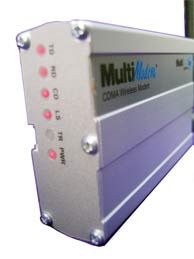|
Cell Sync includes a CDMA cellular receiver, which receives a signal
in a similar manner to a CDMA band cellular telephone. It gets the time
information embedded in the cellular broadcast and passes that time
information to the Cell Sync software running on the computer. Once Cell Sync has synchronized, it
continues to update the computer it is running on regularly.

Our Cell Sync product harnesses the accuracy of
GPS via CDMA signals used by digital cellular/PCS telephones. CDMA
transmissions must be precisely synchronized within ten microseconds for the
protocol to work. Each CDMA base
station, maintained by the cellular operating company, has at least one
highly accurate GPS receiver.
This GPS receiver gets its time from GPS satellites.
In effect, CDMA base stations act as GPS repeaters for time and frequency
applications—an indirect form of GPS. That's why it's sometimes called indirect GPS.
CDMA Technology
In the late 1980's Qualcomm designed a
mobile, cellular telecommunications system offering numerous advantages over
existing systems. This system has been widely accepted, standardized and
deployed throughout the world. It is commonly referred to as CDMA due to its
use of Code Division Multiple Access (CDMA) techniques for servicing
multiple users on the same frequency. It is sometimes referred to as IS-95
after the TIA/EIA standard which defines its signal structure and protocols.
Comparison with GPS Technology
One of its most noteworthy characteristics is the specification of the GPS
timescale as the CDMA mobile telecommunications system timescale. In so
doing, Qualcomm in essence designed a system in which each of the base
stations became a distributor of GPS time. Transmissions from CDMA base
stations are precisely synchronized to UTC time to within ten microseconds.
This has profound implications for users of precise time who are within
receiving range of one of these base stations. Relative to the signals
received by GPS receivers on the earth, signals from the CDMA mobile
telecommunications systems are much stronger. This means that they are
easily received inside buildings.
While GPS receivers offer similar precision
and reliability, GPS antenna installation is often difficult in a business
or industrial environment. For the best reception, GPS receivers require
that an antenna be installed with a wide-angle view of the sky. In some
locations running a cable to the roof or window can be cost-prohibitive.
|


